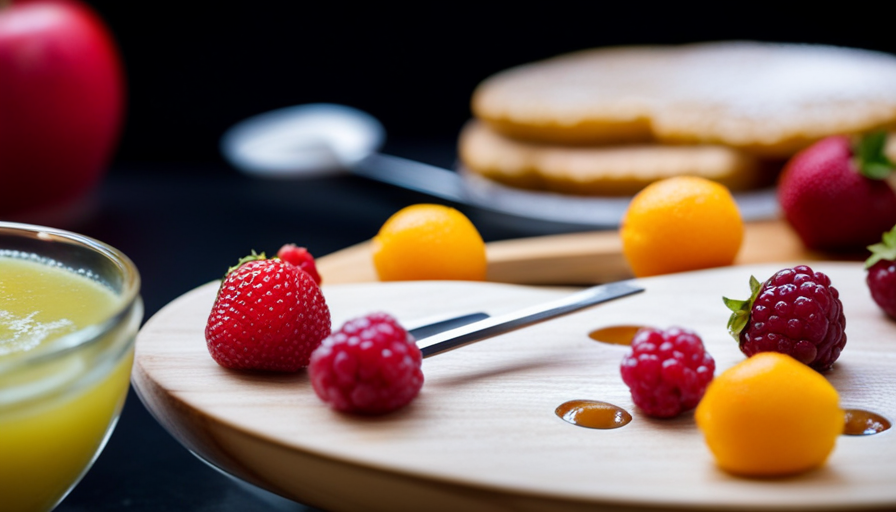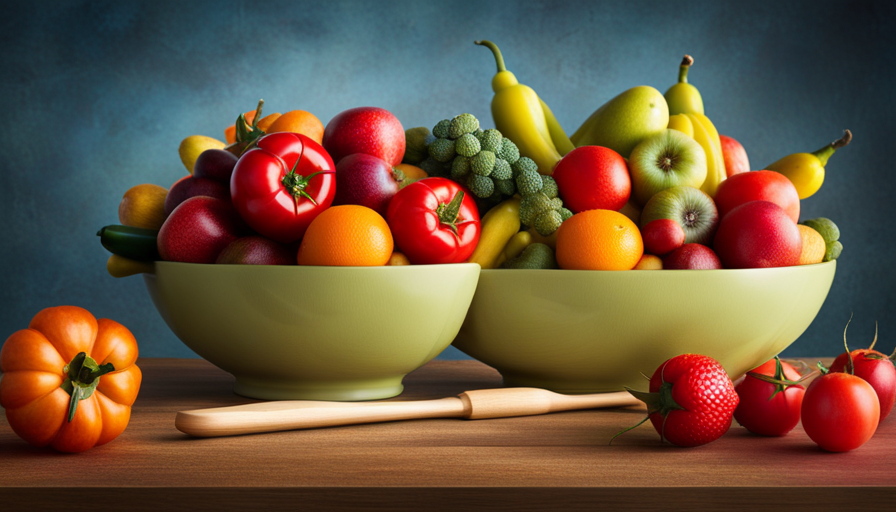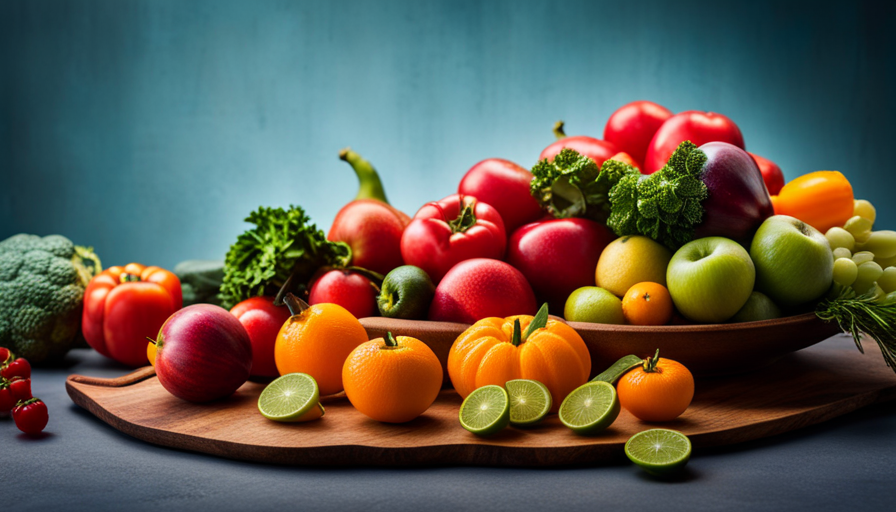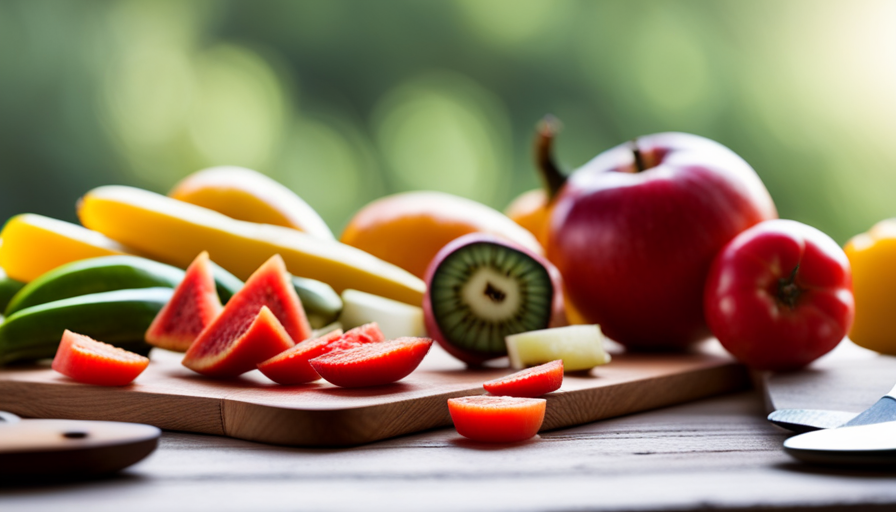Are you prepared to infuse a bit of sweetness into your uncooked culinary creations? Similarly to how a sprinkle of sugar enhances a recipe, incorporating sweet elements into raw dishes symbolizes a boost in taste and an upliftment of the entire culinary experience.
In this article, we will explore various techniques and natural sweeteners that will make your raw dishes irresistible. Using natural sweeteners is a great way to keep your raw food healthy and nutritious. Incorporating fresh fruits not only adds sweetness but also provides essential vitamins and minerals. Dried fruits, such as dates and raisins, bring a concentrated burst of sweetness to your recipes. And have you ever tried raw honey? It not only sweetens but also offers numerous health benefits.
If you’re looking for vegan options, maple syrup and agave nectar are excellent choices. Medjool dates are another fantastic sweetener that is both natural and delicious. And for those watching their sugar intake, stevia provides a sugar substitute that won’t compromise on taste.
Lastly, we will explore how raw cacao and carob can be used to create mouthwatering desserts that will satisfy your sweet tooth. So, let’s dive into the world of sweetening raw food and discover the endless possibilities that await!
Key Takeaways
- Fresh fruits and dried fruits are natural sweeteners that provide sweetness and essential vitamins/minerals.
- Raw honey, maple syrup, agave nectar, and stevia are alternative sweeteners that offer sweetness with additional health benefits or specific dietary considerations.
- Fruit extracts can be used as natural sweeteners without the need for refined sugar.
- Raw cacao and carob are delicious options for creating mouthwatering desserts while providing antioxidants and other health benefits.
Using Natural Sweeteners
If you’re looking for a healthier way to sweeten your raw food, why not try using natural sweeteners? Using fruit extracts can be a great option to add a touch of sweetness without the need for refined sugar. Fruit extracts are made by extracting the natural sugars from fruits like dates, bananas, or apples.
These extracts not only provide a sweet taste, but they also contain beneficial nutrients and fiber.
Exploring alternative sweeteners is another way to sweeten your raw food. Stevia, for example, is a natural sweetener derived from the leaves of the stevia plant. It’s much sweeter than sugar, so a little goes a long way. Another alternative sweetener is raw honey, which is not only sweet but also contains antioxidants and enzymes that can benefit your health.
When using natural sweeteners, it’s important to remember that they can have a different taste compared to refined sugar. Experimenting with different quantities and combinations can help you find the perfect balance for your taste buds. Additionally, keep in mind that natural sweeteners can still contribute to your overall sugar intake, so it’s important to consume them in moderation.
By incorporating natural sweeteners like fruit extracts and exploring alternative options, you can enjoy the sweet taste in your raw food while also taking care of your health.
Incorporating Fresh Fruits
By adding a burst of fruity goodness, your raw dishes will turn into a delightful explosion of flavors that will leave your taste buds begging for more. Incorporating fresh fruits into your raw food not only adds natural sweetness, but also provides essential vitamins, minerals, and antioxidants. One popular way to use fresh fruits is by adding them to smoothies. Whether it’s a classic strawberry-banana blend or a tropical concoction with pineapple and mango, fresh fruits can take your smoothie game to the next level. They bring a refreshing taste and vibrant color that will make your drink more appealing.
Another way to incorporate fresh fruits into your raw food is by adding them to salads. The combination of crisp greens, crunchy vegetables, and juicy fruits creates a perfect balance of flavors and textures. For instance, try adding sliced strawberries or mandarin oranges to your salad for a sweet and tangy twist. You can also experiment with different fruit combinations like watermelon and feta cheese or apple and walnut. The possibilities are endless!
To give you some inspiration, here’s a table showcasing some popular fruits that can be used in smoothies and salads:
| Smoothies | Salads |
|---|---|
| Strawberries | Apples |
| Bananas | Berries |
| Pineapple | Oranges |
| Mango | Watermelon |
| Kiwi | Grapes |
Incorporating fresh fruits into your raw food not only enhances the taste, but also adds a nutritious touch. So go ahead and get creative with your raw dishes by adding a burst of fruity goodness!
Adding Dried Fruits
Adding dried fruits to your dishes will transport your taste buds to a world of rich, chewy goodness that’ll leave you craving for more.
Not only do dried fruits add a burst of sweetness to your raw food, but they also provide a variety of nutrients.
One way to use dried fruits is as a topping. Sprinkle a handful of dried cranberries or raisins onto your raw cereal or yogurt for an extra touch of sweetness. You can also mix dried fruits into your homemade granola or energy bars for added flavor and texture.
Another way to incorporate dried fruits into your raw food is by using them in fruit purees. Simply blend a combination of fresh and dried fruits together to create a smooth and naturally sweet puree. This can be used as a base for smoothies, dressings, or even as a topping for desserts.
Not only will it add natural sweetness, but it’ll also provide a concentrated source of vitamins, minerals, and fiber.
When using dried fruits as a topping or in fruit purees, it’s important to choose varieties that are free from added sugars or preservatives. Look for dried fruits that are organic and unsulfured to ensure you’re getting the most natural and nutritious option.
So go ahead and experiment with dried fruits to add a touch of sweetness and a burst of flavor to your raw food creations. Your taste buds’ll thank you!
Experimenting with Raw Honey
One way to enhance the flavor of your dishes is by incorporating raw honey, such as drizzling it over a bowl of fresh berries for a naturally sweet and indulgent treat. Raw honey not only adds a touch of sweetness, but it also offers a range of health benefits.
For example, a study conducted by a group of researchers found that adding a teaspoon of raw honey to a cup of herbal tea resulted in a unique and delightful taste that surpassed the sweetness of regular sugar, making it a perfect alternative for those looking to reduce their sugar intake.
When experimenting with sweetening raw food, another option to consider is agave syrup. Agave syrup is derived from the agave plant and is often used as a natural sweetener. However, it’s important to note that agave syrup is higher in fructose content compared to raw honey. This means that while it may provide a similar level of sweetness, it may not offer the same health benefits as raw honey.
Exploring the benefits of raw honey, it’s worth mentioning that it contains antioxidants, enzymes, and minerals that can help support a healthy immune system and improve digestion. Additionally, raw honey has been used for centuries for its antibacterial properties, making it a great addition to your raw food dishes.
Incorporating raw honey into your raw food dishes can provide a unique and delightful flavor while offering potential health benefits. However, it’s always a good idea to experiment with other natural sweeteners like agave syrup to find the best option for your taste preferences and dietary needs.
Exploring the World of Maple Syrup
Are you ready to dive into the delicious world of maple syrup and discover new ways to elevate your dishes? Maple syrup, derived from the sap of maple trees, isn’t just a sweetener, but also a versatile ingredient that can be used in a variety of recipes.
Whether you’re looking to add a hint of sweetness to your smoothies, drizzle it over pancakes, or incorporate it into savory dishes, maple syrup’s got you covered.
One of the most popular maple syrup recipes is maple-glazed salmon. The rich and caramelized flavor of the syrup perfectly complements the savory taste of the fish, creating a mouthwatering combination.
Another delightful option is maple-roasted vegetables. Drizzle some maple syrup over your favorite vegetables before roasting them in the oven, and you’ll be amazed at how it enhances their natural sweetness.
Apart from its culinary uses, maple syrup also offers several health benefits. It contains antioxidants and minerals like manganese and zinc, which contribute to supporting a healthy immune system and promoting overall well-being. Additionally, maple syrup is a natural source of energy, making it a great alternative to processed sugars.
So why not explore the world of maple syrup and experiment with its various recipes? Not only will it sweeten your raw food, but it’ll also add a unique depth of flavor that’ll elevate your dishes to a whole new level.
Enhancing Flavors with Coconut Sugar
Ready to take your culinary creations to the next level? Enhance the flavors of your dishes with coconut sugar, a natural alternative to refined sugar that boasts a lower glycemic index, making it a healthier choice for your sweet treats.
Did you know that coconut sugar contains more nutrients, such as potassium and iron, compared to regular sugar?
When it comes to balancing sweetness in raw food, coconut sugar offers a variety of benefits. Here are some alternatives to consider:
-
Date Sugar: Made from dried dates, this natural sweetener adds a rich, caramel-like flavor to your dishes. It’s a great option for adding sweetness to raw desserts like energy balls or crusts.
-
Lucuma Powder: Derived from the Peruvian lucuma fruit, this powder has a subtle sweetness with hints of maple and caramel. It can be used in smoothies, raw cakes, or as a topping for fruit salads.
-
Monk Fruit Sweetener: This zero-calorie sweetener is extracted from monk fruit and can be used as a 1:1 substitute for regular sugar. It has a mild, fruity taste and is perfect for sweetening beverages or raw sauces.
By incorporating these coconut sugar alternatives into your raw food recipes, you can find the perfect balance of sweetness while adding nutritional value to your dishes. Experiment with different options and let your taste buds guide you to create delicious and healthy meals.
Trying Medjool Dates for Natural Sweetness
If you’re looking for alternative sweeteners to enhance the flavors of your raw food, you’ve come to the right place. In our previous subtopic, we discussed the use of coconut sugar to add a touch of sweetness to your dishes. Now, let’s explore another natural sweetener that can elevate your raw food experience: Medjool dates.
Medjool dates are a type of sweet fruit that can be used to create a delicious and healthy syrup. This syrup, often referred to as date syrup, is a wonderful substitute for traditional sweeteners like sugar or honey. Not only does it provide a natural sweetness to your dishes, but it also brings along a myriad of health benefits.
One of the key benefits of using date syrup is its high nutritional value. Dates are packed with essential vitamins and minerals, such as potassium, magnesium, and vitamin B6. Additionally, they are a great source of dietary fiber, which can help regulate digestion and promote a feeling of fullness.
To give you a better idea of the nutritional profile of date syrup, here is a comparison between 1 tablespoon of date syrup and 1 tablespoon of white sugar:
| Nutrient | Date Syrup | White Sugar |
|---|---|---|
| Calories | 60 | 46 |
| Carbohydrates | 16 grams | 12 grams |
| Fiber | 1 gram | 0 grams |
| Potassium | 140 mg | 0 mg |
| Magnesium | 5 mg | 0 mg |
| Vitamin B6 | 0.01 mg | 0 mg |
As you can see, date syrup not only provides sweetness but also brings along valuable nutrients. So, if you’re looking for a healthier way to sweeten your raw food, give date syrup a try!
Using Stevia as a Sugar Substitute
Now let’s dive into the world of using stevia as your go-to sugar substitute, adding a touch of sweetness to your culinary adventures.
Stevia is a natural sweetener derived from the Stevia rebaudiana plant and has gained popularity due to its zero-calorie content and low glycemic index. It’s a great option for those looking to reduce their sugar intake without sacrificing sweetness.
Using stevia in your raw food recipes is simple and convenient. You can find powdered stevia or liquid stevia extract in most grocery stores or online. It’s important to note that stevia is much sweeter than sugar, so a little goes a long way. Start with small amounts and adjust according to your taste preferences.
Another sugar substitute worth exploring in raw desserts is monk fruit. Monk fruit extract, derived from the monk fruit plant, is another zero-calorie sweetener that can be used to enhance the flavor of your raw treats. It has a unique sweetness that some find more pleasant than stevia.
Additionally, xylitol is a sugar alcohol that can be used in raw desserts to add sweetness. It has a similar taste and texture to sugar, making it an excellent substitute in recipes. Xylitol also has the added benefit of being tooth-friendly, as it doesn’t promote tooth decay like regular sugar does.
Using stevia, monk fruit, and xylitol as sugar substitutes in your raw food recipes can provide a natural sweetness without the negative effects of traditional sugar. Experiment with these alternatives to find the perfect balance of flavor and sweetness in your culinary creations.
Utilizing Agave Nectar for a Vegan Option
Utilizing agave nectar as a vegan alternative presents a sophisticated option for enhancing the flavor profiles of your culinary creations. Not only does agave nectar add a touch of sweetness, but it also offers several benefits that make it a popular choice among health-conscious individuals.
Here are four reasons why agave nectar is a great alternative to sweeten your raw food:
-
Low glycemic index: Agave nectar has a lower glycemic index compared to traditional sugar, meaning it won’t cause a rapid spike in blood sugar levels. This makes it a suitable option for those watching their blood sugar levels or following a low glycemic diet.
-
Vegan-friendly: Agave nectar is derived from the sap of the agave plant, making it a natural and cruelty-free sweetener. It’s a great option for vegans who want to avoid using honey, which is derived from bees.
-
Versatility: Agave nectar is liquid in form, making it easy to incorporate into various recipes. Whether you’re sweetening smoothies, dressings, or desserts, agave nectar blends well and evenly distributes its sweetness.
-
Natural flavor: Agave nectar has a distinct yet mild flavor that adds a unique touch to your dishes. It imparts a delicate sweetness without overpowering other flavors, allowing the natural taste of your raw food to shine through.
Agave nectar offers an array of benefits as an alternative sweetener for raw food. Its low glycemic index, vegan-friendly nature, versatility, and natural flavor make it an excellent choice for enhancing the taste of your culinary creations.
Creating Delicious Desserts with Raw Cacao or Carob
Creating delicious desserts with raw cacao or carob is a delightful way to indulge in guilt-free treats, and studies show that incorporating these superfoods into your diet can boost your mood and improve overall well-being.
Raw cacao, often referred to as ‘food of the gods,’ is packed with antioxidants and is known to have numerous health benefits. It contains flavonoids, which have been shown to reduce inflammation, lower blood pressure, and improve heart health. Raw cacao is also a great source of magnesium, iron, and fiber, which can support digestion and promote a healthy gut.
When exploring raw cacao health benefits, it is important to note that it is best consumed in its purest form, as many commercial chocolate products are processed and contain added sugars and fats. Opting for raw cacao powder or nibs allows you to fully experience its rich, chocolatey flavor without any unnecessary additives.
On the other hand, carob is a versatile and nutritious alternative to chocolate. It is naturally sweet and can be used as a substitute in various desserts. However, carob is not just limited to desserts; it can also be incorporated into savory dishes. Carob powder can be used as a thickener in soups, stews, and sauces, adding a mild sweetness and a hint of chocolate-like flavor. It is also a great source of fiber, calcium, and antioxidants.
Incorporating raw cacao and carob into your diet can be a delicious and healthy way to satisfy your sweet tooth while reaping the benefits of these superfoods. So go ahead and indulge in guilt-free desserts or experiment with incorporating carob into your savory dishes for a flavorful twist.
Frequently Asked Questions
Are there any natural sweeteners that can be used in raw food recipes other than honey, maple syrup, coconut sugar, and agave nectar?
Yes, there are alternative sweeteners that can be used in raw food recipes. These include stevia, monk fruit sweetener, date sugar, and yacon syrup. Stevia is a natural, zero-calorie sweetener that comes from the stevia plant. Monk fruit sweetener is made from the extract of monk fruit and is also calorie-free. Date sugar is made from dried dates and provides essential nutrients like fiber and potassium. Yacon syrup is a low-glycemic sweetener that may help regulate blood sugar levels. These alternative sweeteners offer various health benefits and can be great options for sweetening raw food recipes.
Can I use artificial sweeteners in raw food recipes?
Yes, you can use artificial sweeteners in raw food recipes as alternatives to honey and maple syrup. Artificial sweeteners are low-calorie or calorie-free sugar substitutes that can add sweetness to your dishes without the added sugars. Some commonly used artificial sweeteners in raw food recipes include stevia, erythritol, and monk fruit extract. These sweeteners are considered safe for consumption and can be found in various forms such as liquid drops or powdered versions. However, it’s important to use them in moderation and follow the recommended usage guidelines.
How can I adjust the sweetness level in a raw food recipe if I don’t want it to be too sweet?
To adjust the sweetness level in a raw food recipe without making it too sweet, you can try using alternative sweeteners. These can include options like stevia, monk fruit, or coconut sugar. These sweeteners are lower in calories and have a lower glycemic index compared to traditional sugar.
Start by adding a small amount and gradually increase until you reach your desired sweetness. Remember to taste and adjust as you go to find the perfect balance.
Can I use frozen fruits instead of fresh fruits in raw food recipes?
Using frozen fruits in raw food recipes can be a convenient and tasty option. They can add a refreshing twist to your dishes while still maintaining their nutritional value. When using frozen fruits, make sure to thaw them first to avoid a watery texture.
You can also use frozen fruits to make delicious raw desserts like smoothies, ice creams, or fruit sorbets. Just blend them with other ingredients and enjoy a cool and healthy treat.
Are there any specific types of dried fruits that work best for sweetening raw food recipes?
For sweetening raw food recipes, there are several types of dried fruits that work well. Dates, raisins, and dried figs are popular choices due to their natural sweetness. These fruits can be soaked in water to soften them before blending or chopping and adding to your recipes. They’re great substitutes for honey and maple syrup in raw food recipes, as they provide a natural and healthy alternative.
Can Raw Cocoa Butter Be Used as a Sweetener in Raw Food Recipes?
Yes, using raw cocoa butter in food is a great way to add sweetness to raw food recipes. Its rich, natural flavor can enhance the taste of desserts and snacks without the need for processed sugars. Whether it’s in smoothies, energy balls, or raw chocolate treats, raw cocoa butter can be a delicious sweetener alternative.
Conclusion
In conclusion, sweetening raw food can be a delightful journey of exploration and experimentation. By using natural sweeteners like raw honey, maple syrup, and stevia, you can add a touch of sweetness without compromising on health.
Incorporating fresh fruits, dried fruits, and medjool dates can also infuse your raw dishes with natural sweetness and nutrients. And for those looking for a vegan option, agave nectar is a great choice.
So go ahead and indulge in the world of raw desserts with raw cacao or carob, and experience the joy of guilt-free indulgence. It’s like entering a sugar-coated wonderland where every bite is a burst of heavenly sweetness!










